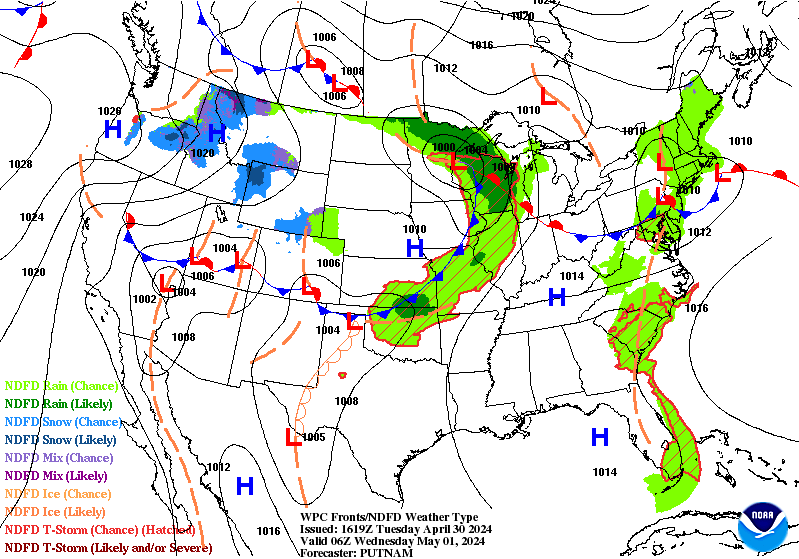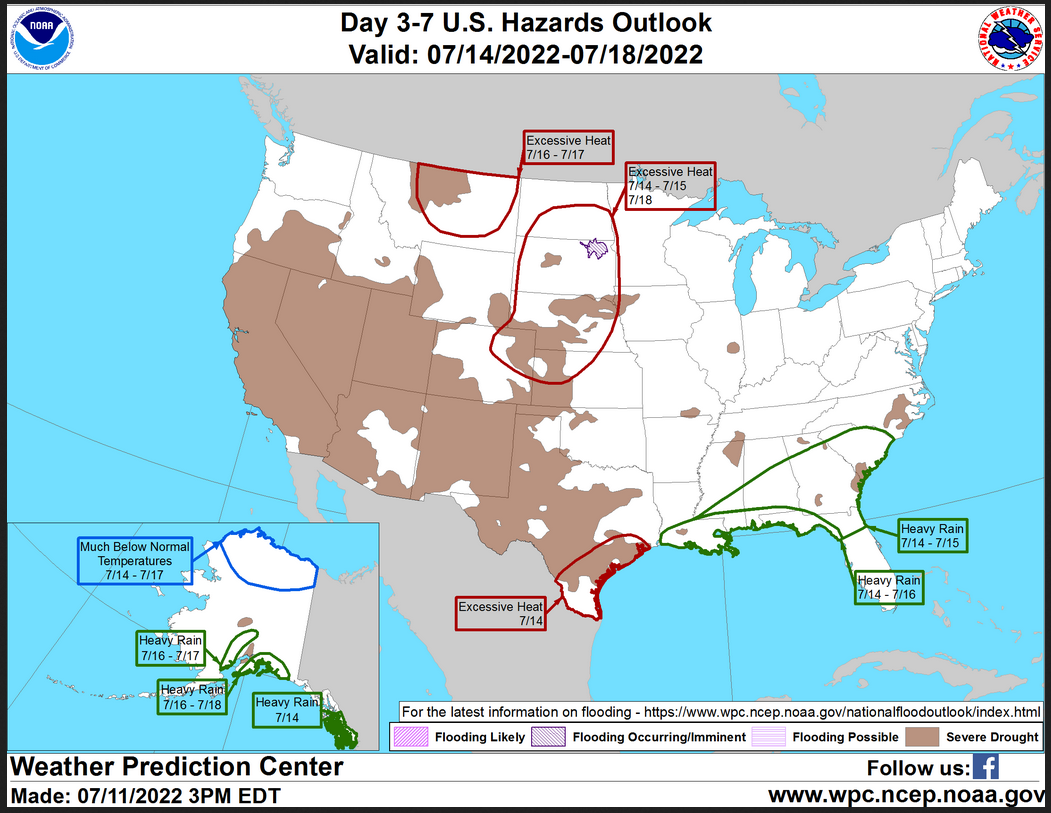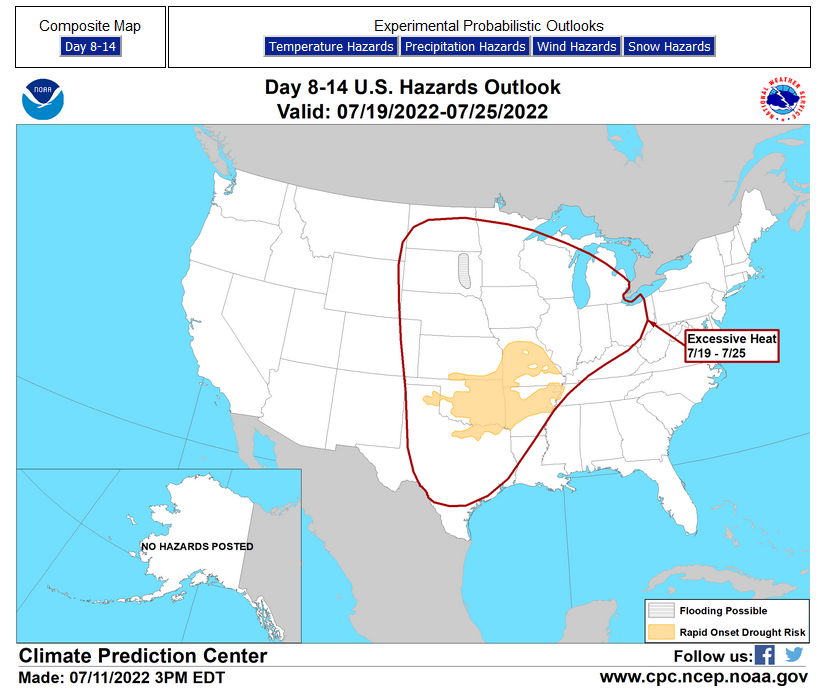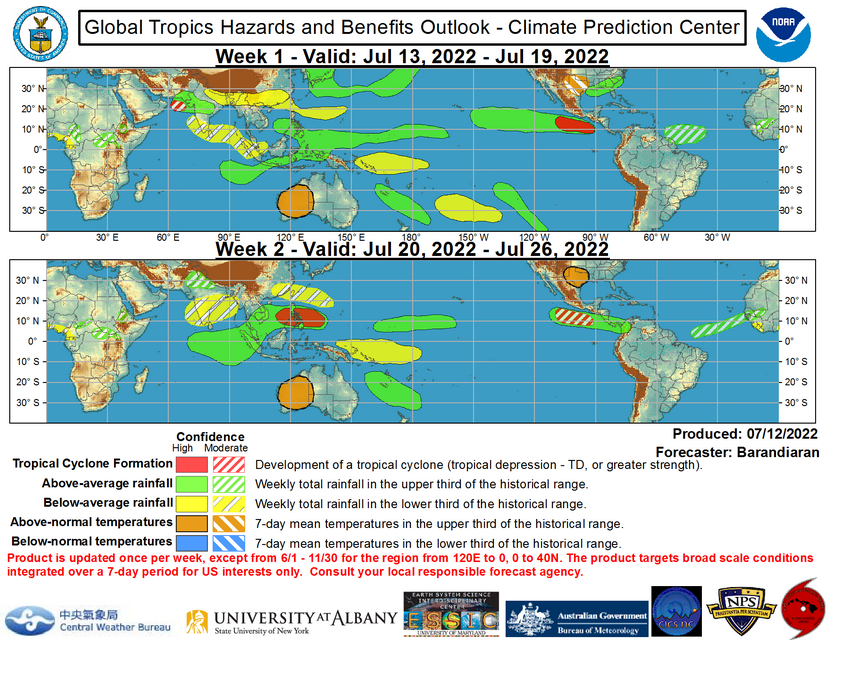Here is what we are paying attention to this evening and the next 48 hours from this evening’s NWS Forecast.
...Dangerous heat to continue across much of the Central and Western United States... ...Heavy rain and possible flash flooding for portions of the Intermountain West, Rockies, and Gulf Coast region through tonight, with severe weather possible across the northern High Plains... ...Instances of flash flooding possible throughout the Ohio Valley on Sunday...
Continuation of the NWS Short Range Forecast (It is updated twice a day and these updates can be found here.
In typical mid-July fashion, many parts of the country are forecast to continue contending with heat and thunderstorms over the next several days. A strong and stagnant upper-level ridge stretching from the Southwest to the southern High Plains will be the driver for above normal temperatures throughout the West and central United States. Highs into the mid-to-upper 90s and triple digits will be widespread over the Great Plains and into parts of the middle/lower Mississippi Valley this weekend. These hot daytime temperatures combined with warm overnight lows around 80 degrees could make conditions particularly dangerous for any residents without access to working air conditioning. Simmering temperatures near the century mark are forecast to persist over northern Plains and Intermountain West through the weekend as well, with even hotter weather found in the Desert Southwest. Arizona, southern Nevada, and central/southern California will see highs soar into the 100s and 110s. Elsewhere, below average temperatures are expected across the Pacific Northwest, while warm and near average temperatures mostly in the 80s remain over the Great Lakes and East Coast. Monsoon season kicked off fairly early this year over the Southwest and for some locations it is expected to peak this afternoon and evening throughout the Colorado River Basin. While much of this region is desperate for rainfall, too much rain in a short period of time could be dangerous. Near record precipitable water amounts streaming from southern Nevada to southern Wyoming will allow for any developing thunderstorms to contain intense rainfall rates. For susceptible terrain, such as burn scars and slot canyons, heavy rainfall could lead to rapid runoff and flash flooding. A Slight Risk (level 2/4) of excessive rainfall has been issued for a broad region that extends from northern Arizona and eastern Nevada to southern Wyoming. Flash Flood Watches have also been issued. By this weekend, thunderstorm chances are expected to continue but become more scattered in nature, leading to additional isolated chances for flash flooding. Farther north, a shortwave trough swinging across the northern Rockies this afternoon may spark thunderstorms capable of containing damaging wind gusts and large hail throughout the northern High Plains. Shifting to the eastern U.S., a sultry airmass draped across the Southeast and Gulf Coast is anticipated to continue producing scattered and unorganized thunderstorm activity through at least the beginning of the weekend. A few storms could produce torrential downpours and remain stationary long enough to produce isolated flash floods. Low-lying areas and urban regions are most at risk for impacts associated with flooding. A Slight Risk of Excessive rainfall is in effect through early Saturday, with the risk areas drastically diminishing for the weekend. Additionally, thunderstorm complexes forming near a slowly lifting warm front extending from the Mid-Mississippi Valley to the Mid-Atlantic this weekend may produce the threat of flash flooding over the Ohio Valley. The latest precipitation forecast depicts widespread 1-3 inches of total rainfall possible, with locally higher amounts likely. The Excessive Rainfall Outlook was upgraded this afternoon to include a Slight Risk from western Pennsylvania to far northeast Arkansas on Sunday, where probabilities are greatest for scattered flash floods to occur.
Maps that relate the forecast to geography can be found by clicking Here for Day 1 and Here for Day 2.
Here is a 60-hour animated forecast map that is updated every 6 hours by NOAA. We will monitor to see if the image here updates automatically or not.
HAZARDS OUTLOOKS
Click here for the latest complete Day 3 -7 Hazards forecast which updates only on weekdays. Once a week probably Monday or Tuesday I will update the images. I provided the link for reads to get daily updates on weekdays. Use your own judgment to decide if you need to update these images.
Worldwide Tropical Forecast
(This graphic updates on Tuesdays) If it has not been updated, you can get the update by clicking here https://www.cpc.ncep.noaa.gov/products/precip/CWlink/ghazards/images/gth_small.png
Detailed Maps and Reports for the Western Atlantic and the Pacific Oceans
Below are three maps that summarize the situation for the Atlantic, Eastern and Central Pacific. Additional information can be accessed by clicking HERE
First the Atlantic
Click to view the forecast map and have access to additional information https://www.nhc.noaa.gov/gtwo.php?basin=atlc&fdays=5
Then Eastern Pacific
Click to view the forecast map and have access to additional information https://www.nhc.noaa.gov/gtwo.php?basin=epac&fdays=5
Then Central Pacific
Click to view the forecast map and have access to additional information https://www.nhc.noaa.gov/gtwo.php?basin=cpac&fdays=5
And the Western Pacific
Click to view the forecast map and have access to additional information https://www.metoc.navy.mil/jtwc/jtwc.html
Some Intermediate-Term Outlooks
Links to “Outlook” maps and discussions for three time periods. Days 6 – 10, Days 8 – 14, and Weeks 3 and 4. An outlook differs from a forecast based on how NOAA uses these terms in that an “outlook” presents information from deviation from normal and the likelihood of these deviations.
You have to click on the links because they do not update automatically and I do not want to have stale images in the article. But it is not difficult to click on a link and you get a large image plus a discussion. On Fridays in a separate article, we will show the images and provide a link in this article that article. But remember what you will see is the images as of Friday. But here you can get the current images simply by clicking on them. Then hit the return arrow at the upper left of your screen to return to the article. You will not find this information easily anywhere else.
Month to Date Information
Temperature
Precipitation
Month to date Temperature can be found at https://hprcc.unl.edu/products/maps/acis/MonthTDeptUS.png
Month to date Precipitation can be found at https://hprcc.unl.edu/products/maps/acis/MonthPNormUS.png







